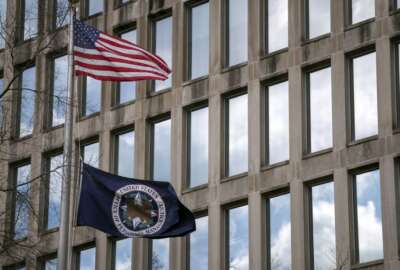Hubbard Radio Washington DC, LLC. All rights reserved. This website is not intended for users located within the European Economic Area.
On Air: Federal News Network
Trending:
From the Old Post Office to FBI headquarters, GSA gets creative with federal property
As the government\'s landlord, the General Services Administration is coming up with creative approaches for how agencies can consolidate their workforces, reth...
Editor’s Note: This story is part of Federal News Radio’s special report, A New Vision for Federal Buildings.
Deciding whether a federal building should be held onto or disposed of really comes down to answering one question.
“Even if the property is being used, is it the highest and best use?” said Norman Dong, commissioner of the Public Buildings Service at the General Services Administration.
He pointed to the Old Post Office Building as an example.
“Technically, the property was being used, but clearly, it wasn’t the highest and best use,” he said. “It was a couple of small agencies and a food court. Through this process of asking the question of highest and best use, we really are trying to leverage the value of our assets for the federal government.”
The next step was deciding how to dispose of the property.
“GSA examined a number of alternatives, including a sale, prior to moving forward with the ground-lease option for the Old Post Office,” said Bill Dowd, PBS’ project executive.
GSA signed a 60-year lease in June 2013 with The Trump Organization to renovate the Old Post Office building.
With the lease option, GSA retained ownership of the property, while leveraging the value of the building’s location on Pennsylvania Avenue to attract developers who would foot the bill for the renovation.
“Through the ground lease through Section 111 of the National Historic Preservation Act, GSA was able to transfer all the risks — those being financial and programmatic — associated with the operation and maintenance of the building to allow for the redevelopment of the highly historic and important property through private-sector funding, to maintain ownership over the long-term, while getting a financial return for annual revenue from the ground lease directly and to solely support other historic assets and properties throughout GSA’s prior historic inventory,” Dowd said.
The Old Post Office project is an example of something that GSA and all agencies are going to have to get better at doing — evaluating their space usage and coming up with creative ways to consolidate their workforces and shed excess property.

In 2013, the Obama administration released its Freeze the Footprint initiative, in which agencies were barred from increasing the square footage they held for office and warehouse space. Now it’s asking them to consider reducing space to generate savings.
As the government’s landlord, GSA owns or leases more than 354 million square feet of office space throughout 9,600 buildings in 2,200 communities across the U.S.
“Freeze the Footprint really has forced agencies to take a hard look at how they’re utilizing space and to challenge agencies to find ways to reduce their space,” Dong said.
During fiscal 2013 and 2014, agencies decreased their warehouse space by 21 million square feet as compared to what they used in 2012.
OMB Controller David Mader told Federal News Radio that in 2014 civilian and DoD agencies got rid of 7,315 buildings, including office space and warehouse space, that equaled 47 million square feet of space. Mader said by getting rid of those buildings, the government saved $17 million in maintenance costs.
New life for Old Post Office Building
GSA already has several big projects underway that reflect this ongoing strategy of rethinking how agencies can consolidate their components, while disposing of or repurposing old properties.
“As we look at consolidation opportunities, we’re looking for getting the best value in terms of whether it’s consolidating multiple agencies into one location or if it’s bringing in one sole tenant, but bringing in their other leases,” GSA’s Acting Administrator Denise Turner Roth told a House Appropriations subcommittee hearing in March.
Two big, high-visibility projects GSA is working on involve properties located on Pennsylvania Avenue in Washington, D.C. — The Old Post Office and the J. Edgar Hoover Building. The former is a 116-year old structure that GSA decided was underutilized and the latter is the home of the FBI, which is looking for a new home in order to consolidate its workforce.
The Old Post Office deal proved to be an attractive one to Trump and the other developers who responded to GSA’s request for proposals.
“It’s just an iconic building,” said David Orowitz, senior vice president of acquisitions and development at Trump. “It’s beautiful. The architecture is dramatic. The location is on Pennsylvania Avenue right in between the White House and Capitol, and it works very well as a luxury hotel. All those things kind of made it very appealing to us and, honestly, to everyone else too. The proposals that were put in were basically every major hotel brand and every local and national developer. So, we weren’t alone in seeing the opportunity here.”
Before handing the keys to the building over to Trump, GSA relocated the National Endowment for the Arts and the National Endowment for the Humanities to the Constitution Center on 7th Street in Southwest D.C.; and The Advisory Council on Historic Preservation to the National Building Museum on F Street.
This is the first time Trump has entered into a deal like this with the GSA, but it has done a number of public-private partnership agreements involving historic properties.
“If you look at Ferry Point up here in New York, we’re working with the City of New York and, basically, building a world-class golf course right in the middle of New York City, which will be spectacular,” Orowitz said. “That’s about to open. That’s really the type of thing we’ve done here in New York a number of times. We run Wollman Rink. We renovated that and we operate it in Central Park. We’ve done public-private partnerships before, but I would say that no one’s really done exactly the type of project that the Old Post Office is, in its size and its importance and its scope and its structure. I think it’s a pretty unique deal.”
The renovated Old Post Office Building is on schedule to reopen in summer 2016 as a 270-suite luxury hotel.
“We’re going to take a building that wasn’t working before, invest a lot of money into it and really create something special and preserve an important part of D.C.,” Orowitz said. “But, secondarily, we’re building a museum. Within the property itself, we’re creating a free museum that tells the story of the Old Post Office and kind of as proxy, the story of D.C. We’re going to continue to have the National Park Service operate the clock tower. People will continue to be able to go up there and see the best views in Washington, D.C. But, Trump, we are actually going to build the museum and create something that people who visit D.C. and residents of D.C. can really enjoy.”
As Orowitz describes it, the renovated Old Post Office would seem to meet Dong’s “highest and best use” criteria. GSA has other reasons to be happy with the deal, as well.
“Basically, through that lease agreement we receive $250,000 per month,” Dowd said. “So that’s $3 million annually in payments. That’s the inflow. We also avoid the maintenance and some of the other requirements that we had on that building.”
The big swap on Pennsylvania Avenue
Further down Pennsylvania Avenue, GSA is taking a different approach to how it’s handling the FBI headquarters project.
Opened in 1975, the Hoover Building is not underutilized, as was the case with the Old Post Office, but it is not meeting the FBI’s needs in its current state.
“The J. Edgar Hoover Building only houses a little more than 50 percent of the FBI headquarters staff,” Dowd said. “In fact, the rest of their headquarter operations are dispersed in 20 leases around the city. Because the J. Edgar Hoover Building is not capable of meeting their space or security needs, it became clear that their operations needed to be consolidated in a new facility.”
Rather than selling the building, renovating it there or entering into a lease-option agreement like the one at the Old Post Office, GSA decided it would swap the Hoover Building for a new headquarters building in the D.C. suburbs that would be built by a private developer.
“We think that combining [the Hoover Building] with this project allows us to leverage the value of that underutilized asset and have it fund the new project directly,” Dowd said. “The other options are that we would need to wait until this project were completely funded and constructed before we might go through an option if we considered the property excess to dispose it. And then that funding would not be directly applicable to this project. It would go into the Federal Building Fund and might be used on something else in the future.”
Dowd added that the swap approach made the most economic sense for GSA and the FBI.
“It allows us to realize the value of that contribution directly and immediately to advance this project,” he said. “Without it, the project would struggle even longer. We’re hopeful that this is a way to infuse some interest and some funding directly into the project and make it a reality.”
Last July, GSA completed a nine-month evaluation process and identified three possible locations for the new FBI headquarters — the Greenbelt Metro and Landover Mall sites in Maryland, and a warehouse facility in Springfield, Virginia.
“The GSA owns the Springfield warehouse site and has purchase option agreements with the landowners of the two sites in Prince George’s County to acquire them if we needed them for the project,” Dowd said. “With the possible sites identified, we’re now in the process of identifying possible exchange partners to prepare the development proposals for consideration.”
GSA issued the first phase of the development RFP back in December, asking interested developer teams to submit their qualifications for consideration by Feb. 10.
“GSA will evaluate all the proposals and identify the most qualified teams to advance to the next phase of the process,” Dowd said. “In the second phase of the RFP, the teams shall be asked to submit specific proposals to provide a new headquarter facility for FBI on one of the sites that we’ve identified for them. And then upon completion of the project, GSA will transfer title to the J. Edgar Hoover Building in exchange for the new facility.”
GSA expects to announce the developer team and project location in summer 2016.
The decision to “swap” the Hoover Building to pay for a new FBI headquarters has met with some incredulity on Capitol Hill.
“You want to, hopefully, make sure you get even-Steven,” said Rep. Ander Crenshaw (R-Fla.), chairman of the House Appropriations Subcommittee on Financial Services and General Government, at GSA’s budget hearing in March. “I hope at the end of the day, when you have this new facility out there somewhere, you’re not going to come to us and ask for more money because it wasn’t a great deal in terms of what the FBI building is worth.”
Acting Administrator Roth defended GSA’s course of action.
“In terms of our approach to all of our portfolio, we are looking for where is the best opportunity,” Roth said. “Do we have properties that are sitting that are not making money? So, with the FBI building in particular, it’s not meeting the needs of the FBI, but that’s in part how it became a target.”
Roth told the subcommittee that GSA had the Hoover Building appraised. In light of the current competitive retail market, she told the committee GSA didn’t want to “show their hand” during the negotiation process.
“The process itself is what’s going to give us both the sense of what the value is we should expect to get out of the current FBI building as well as the new location and the cost there of,” Roth said. “We will get a sense of that out of the proposals that are brought forward. But in terms of the need that brought us to the table, it really has been FBI’s need of having a new facility. The facility that they’re currently in is not meeting their needs.”
DHS is consolidating its components on one campus
The Homeland Security Department is also in the process of consolidating its various components into a single headquarters at the St. Elizabeths campus in Southeast Washington. In July 2013, the Coast Guard cut the ribbon on its new home there. Last October, GSA also awarded the contract for phase two of the $4.5 billion St. Elizabeths renovation.
“We look for projects that are pending or we understand from agencies that they may be interested in going into a consolidated space,” Roth said. “One of the things that is necessary, and we’re seeing that with DHS, is that those agencies have to take a step to being aggressive with their square footage, for example, as an opportunity. With steps of that nature, it allows for us to identify space with DHS. We’ll get 3,000 more people into that location. That’s what we’re looking for.”
GSA hasn’t just been advising other agencies, it’s also been a leader when it comes to rethinking its own space needs and coming up with an innovative solution. In 2013, the agency completed renovations to its headquarters in Washington, D.C.
During phase one of the renovation of the headquarters building, GSA created 50,000 more usable square feet of office space. By adopting an open office space design and promoting telework, it increased the number of employees who work out of the headquarters building to 3,300 from 2,200.
“It’s not just about the number of people that we have in the building,” Dong said. “The building today is very different from the building prior to its renovation, a much more open work space, a collaborative workspace. It also benefits from natural light, where a lot more employees are able to benefit from open space and the natural light.”
In addition to its updated Freeze the Footprint initiative released in March, the White House re-proposed in its fiscal 2016 budget request the Civilian Property Realignment Act to simplify the process agencies use to get rid of excess property.
“CPRA represents an opportunity to do things differently,” Mader said. “We and GSA and other land-holding agencies, because it’s not just GSA, are always looking at, are there other approaches that we could bring forward to the Congress and say, ‘Hey, we think this would be beneficial in helping again push the national strategy.'”
He added that OMB is constantly looking at different approaches to reducing the federal footprint.
“Our sense is that with the results of Freeze the Footprint, we now are asking them [agencies] to take a strategic five-year view and our expectation is for them to be able to accomplish more significant reductions,” Mader said. “We are going from freeze it to being more proactive, establishing standards, and working with the General Services Administration to consolidate offices and look for innovative ways to shrink the overall footprint.”
Read Jared Serbu’s related story on how the Defense Department hopes to eliminate some of its excess property, possibly through another round of BRAC.
RELATED LINKS:
FBI land swap concerns dominate GSA budget hearing
OMB seeks approval for agencies to ante up $15M for cross-agency goals
GSA declares end to cube farms, unveils new approach to office space
Public Buildings commissioner wants to help agencies consolidate, modernize workspace
OMB targets further federal office space reductions
FBI narrows down final locations for new headquarters
Agencies forced to freeze office space footprint
Copyright © 2024 Federal News Network. All rights reserved. This website is not intended for users located within the European Economic Area.
Michael O'Connell
Michael O’Connell is senior digital editor of Federal News Network optimizing content for the best user experience. Follow @moconnellWFED
Follow @moconnellWFED





